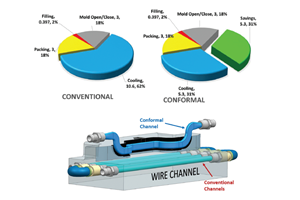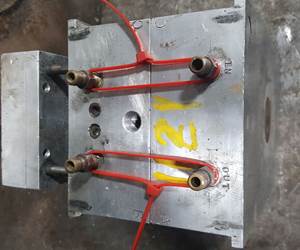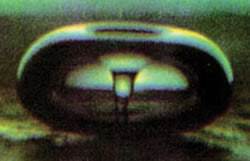Galvanic Corrosion: Prevention Equals Preservation
By educating yourself on some of the common causes of galvanic corrosion, you may save yourself from costly mold repair and rework in the future.
Share
Imagine an assailant that can take on many different forms and sneak up on you at any moment if you're not careful - even when you're most prepared. Its only goal is to steal time, money and productivity away from everyone involved with the toolmaking process. Who is the culprit? Who would do such a thing? Corrosion.
It is the epitome of the expression, "One man's garbage is another man's treasure." If it weren't for the problems that corrosion causes for moldmakers and mold finishers, platers wouldn't be in as much of a demand. Sure, applying a protective coating to your parts offers more benefits than just protection from corrosion - like increased lubricity and release-ability - but protection from corrosion should be your primary concern due to the number of problems that can arise as a result of corrosive damage to your tools.
There are various types of corrosion that most people are aware of such as pitting, where small pits form on the surface on the metal and create problems. Another type of corrosion is uniform attack - for example, a situation in which iron will rust when exposed to air and water and silver will tarnish when exposed to air. A final example of corrosion is stress corrosion, which can result from a combination of applied tensile stress and a corrosive environment.
Galvanic Corrosion
One type of corrosion that is often overlooked in the moldmaking industry is galvanic corrosion, which sometimes is identified wrongly as electrolysis. Galvanic corrosion refers to the damage induced when two dissimilar metals are coupled in a corrosive electrolyte. When this occurs, the less noble (less able to resist this type of corrosion) of the metals in the reaction becomes the anode (positive) and corrodes more quickly than it would by itself, whereas the more noble metal becomes the cathode (negative) and corrodes more slowly than it would alone.
What Is It?
Try to think of it in these terms. Consider the way a battery works. Typically in most batteries there are three things that must be present to create the desired reaction.
- A positive electrode that receives electrons from the external circuit when the cell is discharged. With respect to galvanic corrosion, this refers to the more noble of the two metals.
- A negative electrode that donates electrons to the external circuit as the cell discharges. This refers to the less noble metal or the anode.
- An electrolyte that provides a mechanism for a charge to flow between positive and negative electrodes. This would be the water in the solution for plating or the type of plastic used in the application or any other substance used. Even moisture in the air could act as a catalyst for the reaction.
Once all three of these elements are present, the battery creates energy in which galvanic corrosion is entirely responsible. When this sort of reaction occurs outside of a battery setting, for instance in a mold shop, the energy created by galvanic corrosion manifests itself between the two dissimilar metals and eats away at the less noble of the two.
How Could This Happen?
You may be asking yourself this very same question when a part just doesn't cooperate with you and starts to corrode more quickly than you had anticipated. There are several possible reasons why galvanic corrosion may occur. Because you know that the nobility of metals needs to be considered, a good place to start troubleshooting would be your base metal. If you are using a tool that, over time, has been worked and reworked, you could possibly be working with more than one type of metal - greatly increasing the likelihood of creating a galvanic cell.
Another area of concern should be the purity of the plating tank in which the tool is being treated. If you put an aluminum part into a plating tank, and there are some tiny copper slivers floating around from a previous job, one of those slivers could get plated to the piece. Once that happens, the tool could begin to corrode if it is less noble than the copper. The reason for this is that now there are two dissimilar metals in the presence of an electrolyte such as the water in the solution. Presented in this environment, the copper sliver and the metal part could experience galvanic corrosion by way of the plating solution.
Not putting your parts through the plating process could be another reason why galvanic corrosion may occur. Aluminum has very little nobility and consequently is much more likely to corrode more quickly. Applying a nickel-based coating on your aluminum parts may be what is necessary to protect them from galvanic corrosion. This may not be the case in every instance, but if the part will be in contact with a more noble metal while being exposed to water or another electrolytic agent, this coating may prove beneficial in protecting your part from the galvanic corrosion process.
How Do I Protect Myself?
The first step in protecting yourself is to make sure that you understand galvanic corrosion. This will help you avoid making false assumptions and accusations.
One of the most common methods of avoiding galvanic corrosion is to use a sacrificial anode. Here's the logic: suppose that you are using a nickel solution to plate an aluminum part. Now, if there were any imperfections in that aluminum part, such as pitting, there is a possibility that during the plating process some of the solution or a water molecule could get trapped in that deformity in the part. That water molecule ultimately could become the electrolytic component needed to complete a galvanic cell. The aluminum is less noble than the nickel and so in the plating process used to prevent corrosion and to prolong the life of your part, one could actually be promoting corrosion, and lessening the life of your tool. The solution is to use a sacrificial anode.
To ensure that galvanic corrosion will not occur - even if there is an imperfection in the aluminum - you should place a metal in the solution that is less noble than both nickel and aluminum to sacrifice electrons to the aluminum and endure the corrosive reaction created in the process. This isn't applicable in all situations, but when available, this process has proven itself most beneficial.
One of the more common ways that galvanic corrosion occurs is after the mold has been taken out of the tank. Consider for example, placing an aluminum part in a nickel-plating solution. The aluminum part again has some pitting that hasn't been treated by a resurfacing process. Aluminum and nickel - two obviously dissimilar metals - have been bonded with each other. However, in the pit less nickel has been deposited than on the rest of the piece, so you have an aluminum pit being exposed to nickel - all you need now is a nasty electrolyte to complete the process.
Of course, you can find this electrolyte in abundance floating freely in the air in the form of oxygen. The condensation in the air coupled with the two dissimilar metals completes the equation needed to create a galvanic cell, and thus the process has started. With oxygen introduced to the mix, the corrosion is able to spread much further and faster than it would have had it been created in the previous example.
It is possible to protect yourself from this reaction to the plating process in one of two ways:
Closely inspect the mold for any pitting or surface imperfections and treat them accordingly before proceeding with your plating; and,
Make sure that there is at least 0.0005 in. of nickel is being applied to ensure complete corrosion resistance. This is the minimum amount of nickel needed to cover both the perfect parts of your mold as well as any possible pits or imperfections.
Final Thoughts
Galvanic corrosion is yet another hurdle that the entire mold and die industry must avoid in the quest for success and profitability. Perhaps the most difficult aspect of it is that by the time most people discover it, reworking the part is almost inevitable. It is up to everyone involved to be aware of what galvanic corrosion is and to raise a flag whenever a corrosive element may be introduced or spotted. This industry is not a one-man game - many people are a part of what goes on everyday and consequently responsible when things go wrong. When trying to prevent galvanic corrosion remember to:
- Avoid contact with dissimilar metals far apart on the galvanic table.
- Operate plating tanks with superb filtration.
- Be aware when using your part if any blemishes or imperfections have occurred that may expose the raw metal.
- Don't wait until it's too late to investigate what could be corrosion. Remember that it always is better to be safe than sorry.
Related Content
How to Use Thermal Management to Improve Mold Cooling
A review of common mold cooling issues and possible solutions, including 3D printing applications.
Read MoreWhat You Should Know About Injection Mold Safety Straps
Every mold should have one in order to be safe and OSHA compliant.
Read MorePortable Low-Heat, Non-Arcing Resistance Welder for Mold Repair
Rocklin’s user-friendly MoldMender Micro Welder delivers simple and cost-effective localized repair in-house with precision and versatility, enhancing mold and die durability and reducing disassembly and downtime.
Read MoreHands-on Workshop Teaches Mold Maintenance Process
Intensive workshop teaches the process of mold maintenance to help put an end to the firefighting culture of many toolrooms.
Read MoreRead Next
How to Decrease Your Internal Mold Maintenance Costs, Part 1
With an ultrasonic cleaning system, a mold shop can realize savings in cost, time and labor, as long as they are educated on the technology, the cleaning solutions and what works best for their particular situation/environment.
Read MoreHow to Use Strategic Planning Tools, Data to Manage the Human Side of Business
Q&A with Marion Wells, MMT EAB member and founder of Human Asset Management.
Read MoreAre You a Moldmaker Considering 3D Printing? Consider the 3D Printing Workshop at NPE2024
Presentations will cover 3D printing for mold tooling, material innovation, product development, bridge production and full-scale, high-volume additive manufacturing.
Read More.jpg;maxWidth=970;quality=90)













.jpg;maxWidth=300;quality=90)







